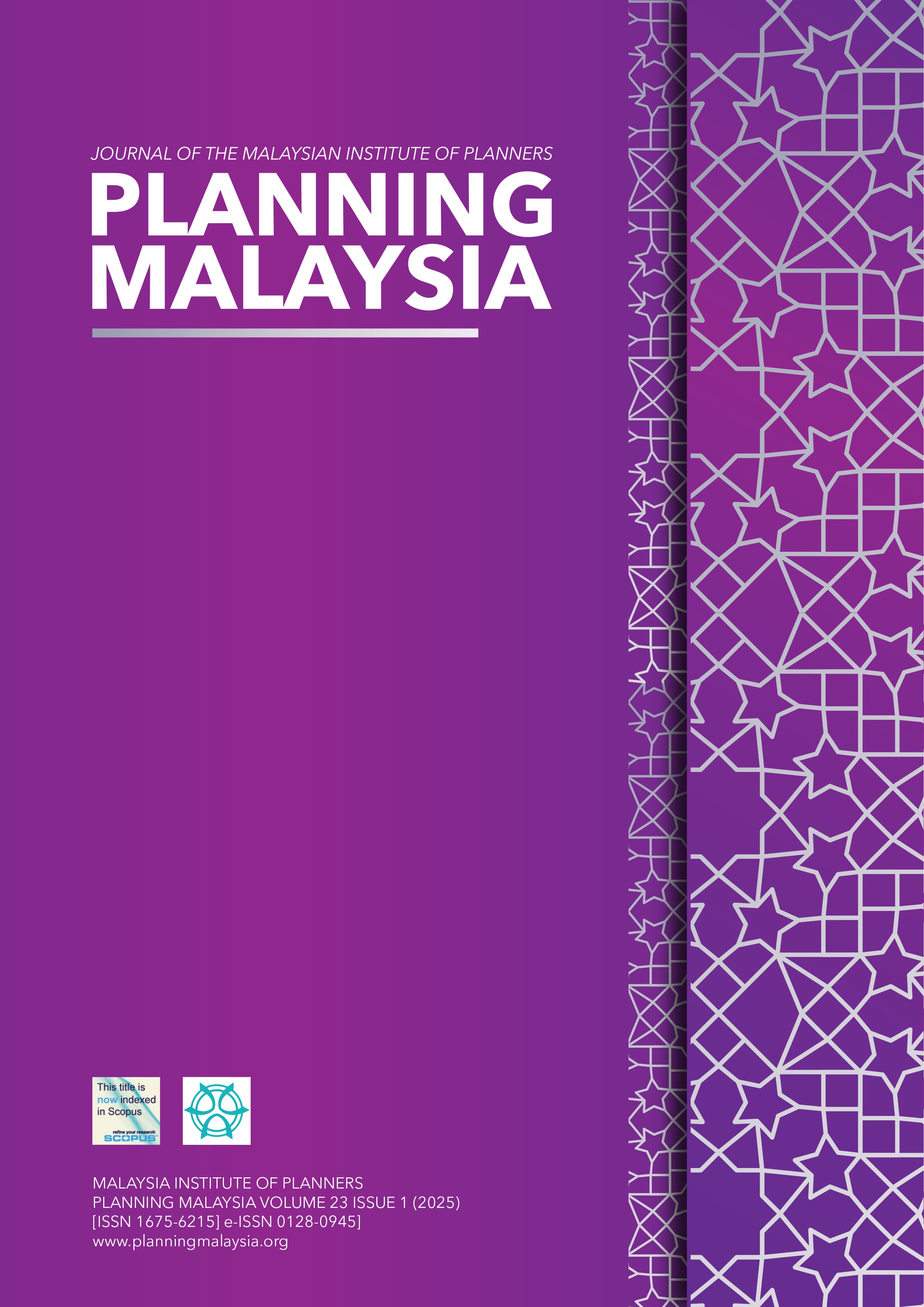LANDSLIDE SUSCEPTIBILITY ANALYSIS USING REMOTE SENSING AND GIS: A CASE STUDY IN HULU LANGAT, SELANGOR, MALAYSIA
DOI:
https://doi.org/10.21837/pm.v23i35.1676Keywords:
landslide, susceptibility, remote sensingAbstract
Landslides pose significant hazards globally, especially in expanding populations in unstable areas. This study uses geospatial analysis for landslide susceptibility in Hulu Langat, Selangor, Malaysia. The primary objectives are to understand landslide factors, analyse susceptibility, and recommend mitigation strategies. The methodology involves the Analytic Hierarchy Process (AHP) evaluating nine parameters: elevation, slope terrain, slope aspect, lithology, soil types, distance from rivers, land cover, precipitation, and distance from faults. Key findings show lower elevations, specific soils, acid intrusive lithology, and proximity to rivers and faults are particularly susceptible to landslides. Findings show that Landslide Concern Zone (LCZ) are mainly dispersed along the vicinity of Sungai Langat and Sungai Semenyih. The study emphasizes tailored mitigation, proactive land-use planning, and integration of disaster management with urban planning to enhance resilience and inform policy.
Downloads
References
Aksha, S. K., Resler, L. M., Juran, L., & Carstensen, L. W. (2020). A geospatial analysis of multi-hazard risk in Dharan, Nepal. Geomatics, Natural Hazards and Risk, 11(1), 88–111. https://doi.org/10.1080/19475705.2019.1710580 DOI: https://doi.org/10.1080/19475705.2019.1710580
Althuwaynee, O. F., Pradhan, B., & Ahmad, N. (2015). Estimation of rainfall threshold and its use in landslide hazard mapping of Kuala Lumpur metropolitan and surrounding areas. Landslides, 12(5), 861–875. https://doi.org/10.1007/s10346-014-0512-y DOI: https://doi.org/10.1007/s10346-014-0512-y
Bahagian Penyelidikan dan Pembangunan. (2011). Garis panduan perancangan : pembangunan di kawasan bukit dan tanah tinggi. PLANMalaysia.
Chelariu, O. E., Minea, I., & Iațu, C. (2023). Geo-hazards assessment and land suitability estimation for spatial planning using multi-criteria analysis. Heliyon, 9(7). DOI: https://doi.org/10.1016/j.heliyon.2023.e18159
Department of Statistic, Malaysia (2022). Key findings population and housing census of Malaysia 2020.
Dou, J., Bui, D. T., Yunus, A. P., Jia, K., Song, X., Revhaug, I., Xia, H., & Zhu, Z. (2015). Optimization of causative factors for landslide susceptibility evaluation using remote sensing and GIS data in parts of Niigata, Japan. PLoS ONE, 10(7). https://doi.org/10.1371/journal.pone.0133262 DOI: https://doi.org/10.1371/journal.pone.0133262
El Jazouli, A., Barakat, A., & Khellouk, R. (2019). GIS-multicriteria evaluation using AHP for landslide susceptibility mapping in Oum Er Rbia high basin (Morocco). Geoenvironmental Disasters, 6(1). https://doi.org/10.1186/s40677-019-0119-7 DOI: https://doi.org/10.1186/s40677-019-0119-7
Gaidzik, K., & Ramírez-Herrera, M. T. (2021). The importance of input data on landslide susceptibility mapping. Scientific Reports, 11(1). https://doi.org/10.1038/s41598-021-98830-y DOI: https://doi.org/10.1038/s41598-021-98830-y
Highland, L. M., & Bobrowsky, P. (2008). The Landslide Handbook - A Guide to Understanding Landslides. DOI: https://doi.org/10.3133/cir1325
Ibrahim, M. B., Mustaffa, Z., Balogun, A. B., Indra, S. H. H., & Nur Ain, A. (2022). Landslide’s analysis and Hazard mapping based on Analytic Hierarchy Process (AHP) using GIS, in Lawas, Sabah-Sarawak. IOP Conference Series: Earth and Environmental Science, 1064(1). https://doi.org/10.1088/1755-1315/1064/1/012031 DOI: https://doi.org/10.1088/1755-1315/1064/1/012031
Ibrahim, I., Ab Ghani, N. & Asmawi, M. Z. (2024). Flood susceptibility assessment using multi-criteria analysis: Case Study in Selangor, Putrajaya, and Kuala Lumpur, IOP Conference Series: Earth and Environmental Science, 1412. doi:10.1088/1755-1315/1412/1/012009 DOI: https://doi.org/10.1088/1755-1315/1412/1/012009
Kalimuthu, H., Wooi, N. T., & Ahmad Fauzi, M. F. (2015). Assessing Frequency Ratio Method for Landslide Susceptibility Mapping in Cameron Highlands, Malaysia. DOI: https://doi.org/10.1109/SCORED.2015.7449440
Lee, S., & Pradhan, B. (2007). Landslide hazard mapping at Selangor, Malaysia using frequency ratio and logistic regression models. Landslides, 4(1), 33–41. https://doi.org/10.1007/s10346-006-0047-y DOI: https://doi.org/10.1007/s10346-006-0047-y
Mahmud, A. R. Alnaimat, A. & Billa, R. (2013). Landslide susceptibility mapping using averaged weightage score and GIS: A case study at Kuala Lumpur. Pertanika Journal of Science and Technology.
Ntelis, G., Maria, S., & Efthymios, L. (2019). Landslide Susceptibility Estimation Using GIS. Evritania Prefecture: A Case Study in Greece. Journal of Geoscience and Environment Protection, 07(08), 206–220. https://doi.org/10.4236/gep.2019.78015 DOI: https://doi.org/10.4236/gep.2019.78015
Saadatkhah, N., Kassim, A., Min Lee, L., Haruna Yunusa, G., Bahru, J., & Malaysia, J. (2015). Quantitative Hazard Analysis for Landslides in Hulu Kelang area, Malaysia (Vol. 73). www.jurnalteknologi.utm.my DOI: https://doi.org/10.11113/jt.v73.2977
Schulte K. (2024). Fundamental of Geology, Columbia Basin College.
Shuib, M. K., Manap, M. A., Tongkul, F., Abd Rahim, I., Jamaludin, T. A., Surip, N., Abu Bakar, R., Che Abas, M. R., Che Musa, R., & Ahmad, Z. (2017). Active Faults in Peninsular Malaysia with Emphasis on Active Geomorphic Features Of Bukit Tinggi Region. Malaysian Journal of Geosciences, 1(1), 13–26. https://doi.org/10.26480/mjg.01.2017.13.26 DOI: https://doi.org/10.26480/mjg.01.2017.13.26
Sofiyan Sulaiman, M., Nazaruddin, A., Zainal Abidin, R., Devi Miniandi, N., Mohd Salleh, N., & Hafidz Yusoff, A. (2019). Landslide Occurrences in Malaysia Based on Soil Series and Lithology Factors. International Journal of Advanced Science and Technology, 28(18), 1–26.
Sur, U., Singh, P., & Meena, S. R. (2020). Landslide susceptibility assessment in a lesser Himalayan road corridor (India) applying fuzzy AHP technique and earth-observation data. Geomatics, Natural Hazards and Risk, 11(1), 2176–2209. https://doi.org/10.1080/19475705.2020.1836038 DOI: https://doi.org/10.1080/19475705.2020.1836038
Vakhshoori, V., & Zare, M. (2018). Is the ROC curve a reliable tool to compare the validity of landslide susceptibility maps? Geomatics, Natural Hazards and Risk, 9(1), 249–266. https://doi.org/10.1080/19475705.2018.1424043 DOI: https://doi.org/10.1080/19475705.2018.1424043
Wubalem, A. (2021). Landslide susceptibility mapping using statistical methods in Uatzau catchment area, northwestern Ethiopia. Geoenvironmental Disasters, 8(1), 1. https://doi.org/10.1186/s40677-020-00170-y DOI: https://doi.org/10.1186/s40677-020-00170-y
Wubalem, A. (2022). Landslide Inventory, Susceptibility, Hazard and Risk Mapping. In Landslides. IntechOpen. https://doi.org/10.5772/intechopen.100504 DOI: https://doi.org/10.5772/intechopen.100504
Zulkafli, S. A., Majid, N. A., Zakaria, S. Z. S., Razman, M. R., & Ahmed, M. F. (2023). Influencing Physical Characteristics of Landslides in Kuala Lumpur, Malaysia. Pertanika Journal of Science and Technology, 31(2), 995–1010. https://doi.org/10.47836/pjst.31.2.18 DOI: https://doi.org/10.47836/pjst.31.2.18
Downloads
Published
How to Cite
Issue
Section
License

This work is licensed under a Creative Commons Attribution-NonCommercial-NoDerivatives 3.0 Unported License.
Copyright & Creative Commons Licence
eISSN: 0128-0945 © Year. The Authors. Published for Malaysia Institute of Planners. This is an open-access article under the CC BY-NC-ND license.
The authors hold the copyright without restrictions and also retain publishing rights without restrictions.


